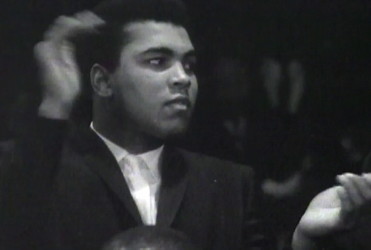 By John F. McKenna (McJack): In Ali’s next fight against Ernie Terrell in February 1967 he again demonstrated his greatness as a fighter. Terrell at 6’6” was considered to be a very good fighter with a great left jab and above average boxing skills.
By John F. McKenna (McJack): In Ali’s next fight against Ernie Terrell in February 1967 he again demonstrated his greatness as a fighter. Terrell at 6’6” was considered to be a very good fighter with a great left jab and above average boxing skills.
Terrell was no match however against Ali and was beaten badly over 15 rounds. You got the feeling that Muhammad could have knocked out Terrell whenever he chose to and simply wanted to torture Ernie for his refusal to call him by his Muslim name. Many people had thought before the fight that Terrell had a real chance against Ali, but again Ali’s speed was too much for Ernie to cope with.
In Ali’s last fight before going into exile he handled top contender Zora Folley like he was a rank amateur before knocking him out in the 7th round. In this writer’s view Ali would never achieve the same level of greatness he had from the time he defeated Liston in their 1st fight in February 1964 until he went into exile in April 1967. Ali was stripped of his title at that time and would not fight again for 3 ½ years when he fought Jerry Quarry in October of 1970.
Again I watched that fight on closed circuit television at the Cherry Hill Arena. I was struck by the change in the make up of the crowd. Whereas before Ali had been vilified for standing up for his beliefs in refusing to be drafted, the crowd, now mostly white, was clearly pulling for Muhammad. And while Ali was still a great fighter, the 3 ½ years he had spent in exile had seen some deterioration in his once unmatched boxing skills.
Ali went on to achieve some of his greatest victories after he came out of exile in 1970, but he was now just a mere mortal. He lost to Joe Frazier and Ken Norton, fighters who were really not in the same league as the pre exile Ali. Instead of staying on his toes for an entire fifteen rounds Ali would sometimes dance for thirty second intervals just to dazzle the crowd. His greatest victory over George Foreman was as much tactical as physical.
In an interview six months before the Forman fight trainer Angelo Dundee prophesied what would happen when Ali and Foreman squared off in the ring. Dundee, always a good judge of a fighter’s attributes, said that his fighter (Ali) would wear down the larger, more muscular Foreman. Because of Foreman’s build, Dundee said, he would run out of gas after about eight rounds at which point Ali would knock him out. The knockout Dundee predicted would come more from big George being exhausted than from any devastating punch.
As it turned out Dundee’s prophesy could not have been more accurate. The closest comparisons that can be made to Ali’s dominance of the heavyweight division from 1964 to 1967 are Jack Dempsey’s annihilation of the heavyweight division from 1919 when he KO’d Jess Willard in three rounds until 1923 when he pole axed Luis Angel Firpo in two rounds. Joe Louis dominated in the same fashion when he won the heavyweight title in 1937 and beat all comers until entering the service in 1942 at the start of World War II.
Ali was known for a number of good quotes, but my very favorite was what he said to reporters who were getting on him about his tendency to brag. He shot back:
“It ain’t bragging if you can back it up!”
“When We Were Kings” was a 1996 documentary about the “Rumble in the Jungle” in Zaire which accurately depicted the events leading up to and including Muhammad Ali’s famous fight with George Foreman in October 1974. The film won an Academy Award.
In one scene from the documentary Ali is seen walking into the ring in Zaire with his entourage following him looking dejected. At one point Ali turns around and chastises them for their unbelief in him. It is a remarkable scene and demonstrated that he had the rare ability to believe in himself when no one else did.
Comments are closed.